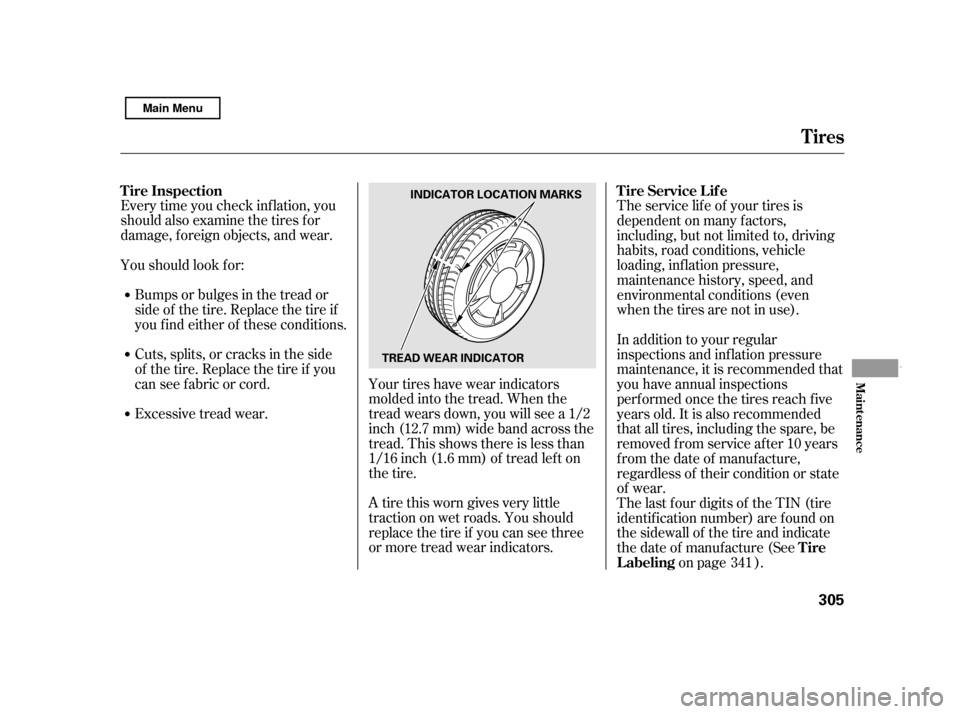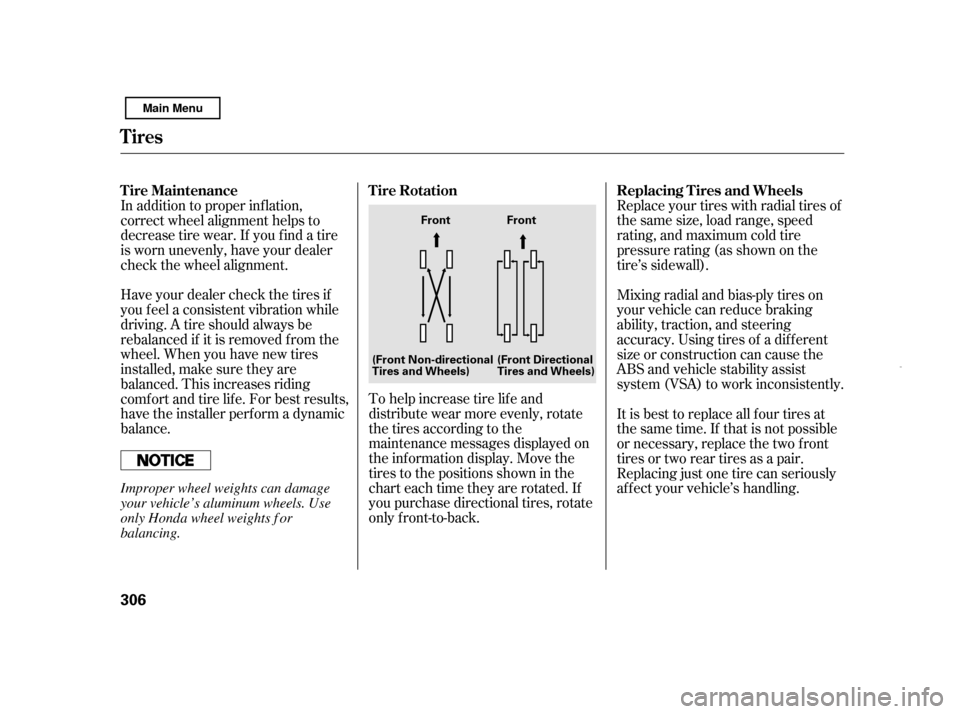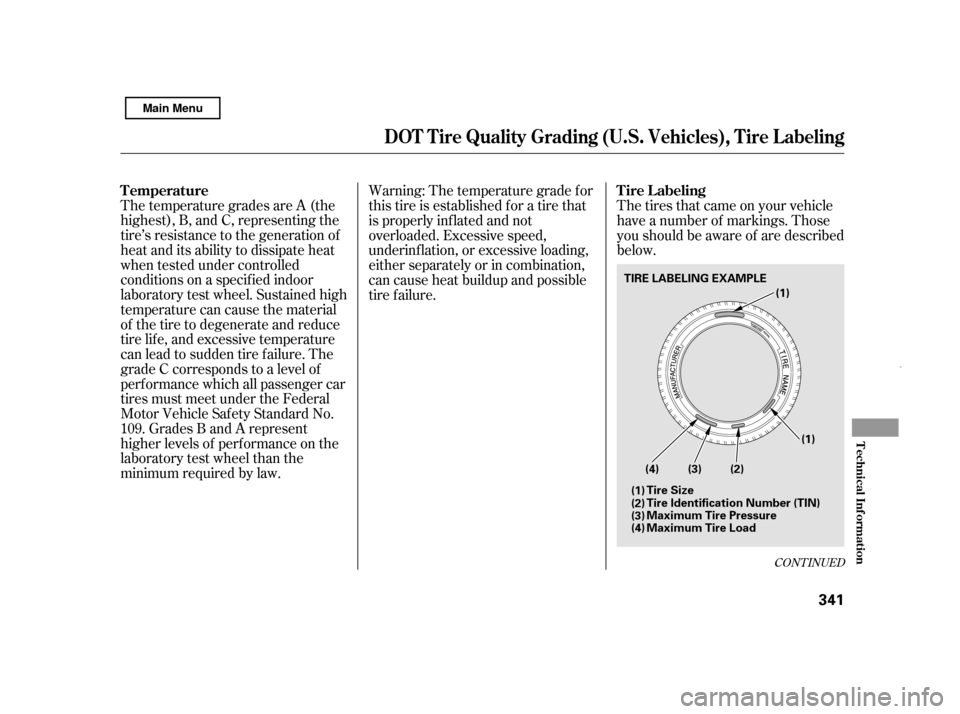Page 309 of 369

A tire this worn gives very little
traction on wet roads. You should
replace the tire if you can see three
or more tread wear indicators.
Every time you check inf lation, you
should also examine the tires f or
damage, f oreign objects, and wear.
Youshouldlookfor:
Bumps or bulges in the tread or
side of the tire. Replace the tire if
youfindeitherof theseconditions.
Cuts, splits, or cracks in the side
of the tire. Replace the tire if you
can see f abric or cord.
Excessive tread wear. Your tires have wear indicators
molded into the tread. When the
tread wears down, you will see a 1/2
inch (12.7 mm) wide band across the
tread. This shows there is less than
1/16 inch (1.6 mm) of tread lef t on
the tire. The service lif e of your tires is
dependent on many f actors,
including, but not limited to, driving
habits, road conditions, vehicle
loading, inf lation pressure,
maintenance history, speed, and
environmental conditions (even
when the tires are not in use).
The last four digits of the TIN (tire
identif ication number) are f ound on
the sidewall of the tire and indicate
the date of manufacture (See
on page ).
In addition to your regular
inspections and inf lation pressure
maintenance, it is recommended that
you have annual inspections
perf ormed once the tires reach f ive
years old. It is also recommended
that all tires, including the spare, be
removed f rom service after 10 years
from the date of manufacture,
regardless of their condition or state
of wear.
341
Tire Inspection
Tire Service Lif e
Tire
Labeling
Tires
Maint enance
305
INDICATOR LOCATION MARKS
TREAD WEAR INDICATOR
Main Menu
Page 310 of 369

Replace your tires with radial tires of
the same size, load range, speed
rating, and maximum cold tire
pressure rating (as shown on the
tire’s sidewall).
To help increase tire lif e and
distribute wear more evenly, rotate
the tires according to the
maintenance messages displayed on
the information display. Move the
tires to the positions shown in the
chart each time they are rotated. If
you purchase directional tires, rotate
only f ront-to-back.
In addition to proper inf lation,
correct wheel alignment helps to
decrease tire wear. If you f ind a tire
is worn unevenly, have your dealer
check the wheel alignment.
Have your dealer check the tires if
you f eel a consistent vibration while
driving. A tire should always be
rebalanced if it is removed f rom the
wheel. When you have new tires
installed, make sure they are
balanced. This increases riding
comf ort and tire lif e. For best results,
have the installer perform a dynamic
balance.
Mixing radial and bias-ply tires on
your vehicle can reduce braking
ability, traction, and steering
accuracy. Using tires of a dif f erent
size or construction can cause the
ABS and vehicle stability assist
system (VSA) to work inconsistently.
It is best to replace all f our tires at
thesametime.If thatisnotpossible
or necessary, replace the two f ront
tires or two rear tires as a pair.
Replacing just one tire can seriously
af f ect your vehicle’s handling.
Tires
Replacing T ires and Wheels
Tire Rotation
T ire Maintenance
306 Front
(Front Non-directional
Tires and Wheels) (Front Directional
Tires and Wheels)
Front
Improper wheel weights can damage
your vehicle’s aluminum wheels. Use
only Honda wheel weights f or
balancing.
Main Menu
Page 311 of 369

�´
Tires marked ‘‘M S’’ or ‘‘All
Season’’ on the sidewall have an all-
weather tread design suitable for
most winter driving conditions.
For the best perf ormance in snowy
or icy conditions, you should install
snow tires or tire chains. They may
be required by local laws under
certain conditions.
If you mount snow tires on your
vehicle, make sure they are radial
tires of the same size and load range
as original tires. Mount snow tires on
all f our wheels. The traction
provided by snow tires on dry roads
maybelowerthanyouroriginaltires.
Check with the tire dealer f or
maximum speed recommendations.
See page f or DOT tire quality
grading inf ormation, and page
f or tire size inf ormation.
Tires:
Wheels:
The ABS and VSA system work by
comparing the speed of the wheels.
When replacing tires, use the same
size originally supplied with the
vehicle. Tire size and construction
can af f ect wheel speed and may
cause the ABS or VSA system to
activate.
If you ever replace a wheel, make
sure that the wheel’s specif ications
match those of the original wheels.
Also be sure you use only TPMS
specif ic wheels (if equipped). If you
do not, the tire pressure monitoring
system will not work.
Replacement wheels are available at
your dealer.
340
342
CONT INUED
Tires
Winter Driving
Wheel and T ire Specif ications
Snow T iresMaint enance
307
P195/65R15 89S
15x6J
Installing improper tires on your
vehicle can affect handling and
stability. This can cause a crash
in which you can be seriously
hurt or killed.
Always use the size and type of
tires recommended in this
owner’s manual.
Main Menu
Page 315 of 369

This section covers the more
common problems that motorists
experience with their vehicles. It
gives you inf ormation about how to
safely evaluate the problem and what
to do to correct it. If the problem has
stranded you on the side of the road,
you may be able to get going again.
If not, you will also f ind instructions
on getting your vehicle towed.......................
Compact Spare Tire . 312
....................
Changing a Flat Tire . 313
.............
If the Engine Won’t Start . 317
................................
Jump Starting . 319
..............
If the Engine Overheats . 321
.........
Low Oil Pressure Indicator . 323
..........
Charging System Indicator . 324
.......
Malf unction Indicator Lamp . 325
...............
Brake System Indicator . 326
..............................................
Fuses . 327
..............................
Fuse Locations . 331
......................
Emergency Towing . 333
Taking Care of the Unexpected
T aking Care of t he Unexpect ed
311
Main Menu
Page 316 of 369

Check the air pressure of the
compact spare tire every time you
check the other tires. It should be
inf lated to:Follow these precautions:
Never exceed 50 mph (80 km/h).
This tire gives a harsher ride and
less traction on some road
surf aces. Use greater caution
while driving.
Replace the tire when you can see
the tread wear indicator bars. The
replacement tire should be the same
size and design, mounted on the
samewheel.Thesparetireisnot
designed to be mounted on a regular
wheel, and the spare wheel is not
designed f or mounting a regular tire.
Do not mount snow chains on the
compact spare tire.
Do not use your compact spare
tire on another vehicle unless it is
thesamemakeandmodel.
Use the compact spare tire as a
temporary replacement only. Get
your regular tire repaired or replaced,
and put it back on your vehicle as
soon as you can.
On vehicles with the TPMS
system, the low tire pressure
indicator comes on and stays on
af ter you replace the flat tire with
the compact spare tire. Af ter
several miles (kilometers) driving
with the compact spare tire, the
TPMS indicator comes on and the
low tire pressure indicator goes of f .
Compact Spare Tire
312 INDICATOR LOCATION MARK
TREAD WEAR INDICATOR BAR
60 psi (420 kPa , 4.2 kgf/cm
)
Main Menu
Page 339 of 369

�µ
Thediagramsinthissectiongive
you the dimensions and capacities of
your vehicle and the locations of the
identif ication numbers. It also
includes inf ormation you should
know about your vehicle’s tires and
emissions control systems.
................
Identif ication Numbers . 336
................................
Specif ications . 338
DOT Tire Quality Grading
......................
(U.S. Vehicles) . 340
Unif orm Tire Quality ..................................
Grading . 340
.................................
Treadwear . 340
......................................
Traction . 340
.............................
Temperature . 341
.................................
Tire Labeling . 341
Tire Pressure Monitoring System
(TPMS) Required Federal ............................
Explanation . 343 .......................
Emissions Controls . 345
.....................
The Clean Air Act . 345
Crankcase Emissions Control
....................................
System . 345
Evaporative Emissions Control ....................................
System . 345
Onboard Ref ueling Vapor
................................
Recovery . 345
...
Exhaust Emissions Controls . 346
....................
PGM-FI System . 346
Ignition Timing Control
................................
System . 346
Exhaust Gas Recirculation ...................
(EGR) System . 346
Three Way Catalytic ...........................
Converter . 346
....................
Replacement Parts . 346
..
Three Way Catalytic Converter . 347
........................
Emissions Testing . 348
T echnical Inf ormat ion
T echnical Inf ormat ion
335
Main Menu
Page 343 of 369
�µ�µ�µ�µ
�µ �µ
Specif ications
Technical Inf ormat ion
339
Air Conditioning
Fuses
Alignment
12 Volt Battery Tires
Lights
HFC-134a (R-134a)
14.1 15.9 oz (400 450 g) SE-10Y
60 W
3CP
21/5 W
21 W
7°6’1°39’ 0°3’
0.00 in (0.0 mm)
P195/65R15 89S 2.0 in (2.0 mm)
Refrigerant type
Charge quantity
Lubricant oil type
Interior
Under-hood
Toe-in
CamberCaster
51 W
21 W 5W 8W8W5W
Capacity 12 V 35 AH/20 HR T135/80D15 99M
32 psi (220 kPa , 2.2 kgf/cm
)
60 psi (420 kPa , 4.2 kgf/cm)
Size
Pressure
2CP
12 V 28 AH/5 HR 24/2.2 CP
Headlights
Front turn signal/side marker
lights
Rear turn signal lights
Brake/Taillights (in fenders)
Back-up lights
Rear side marker lights
Taillights (in trunk lid)
License plate lights
Ceiling light
Spotlights
Trunk light See page 332 or the fuse label
attached to the inside of the fuse
box door under the steering
column.
See page 331 or the fuse box
cover.
FrontRear
FrontRear
Front
HighLow
(HB3)(HB4)
Front/Rear
Spare
Front/Rear
Spare
Main Menu
Page 345 of 369

The temperature grades are A (the
highest), B, and C, representing the
tire’s resistance to the generation of
heat and its ability to dissipate heat
when tested under controlled
conditions on a specif ied indoor
laboratory test wheel. Sustained high
temperature can cause the material
of the tire to degenerate and reduce
tire life, and excessive temperature
can lead to sudden tire f ailure. The
grade C corresponds to a level of
perf ormance which all passenger car
tires must meet under the Federal
Motor Vehicle Saf ety Standard No.
109. Grades B and A represent
higher levels of perf ormance on the
laboratory test wheel than the
minimum required by law.Warning: The temperature grade f or
this tire is established f or a tire that
is properly inf lated and not
overloaded. Excessive speed,
underinf lation, or excessive loading,
either separately or in combination,
can cause heat buildup and possible
tire f ailure.
The tires that came on your vehicle
have a number of markings. Those
you should be aware of are described
below.
CONT INUED
Temperature
Tire L abeling
DOT Tire Qualit y Grading (U.S. Vehicles), Tire L abeling
T echnical Inf ormat ion
341
(4) (3) (2)
(1)
(1)
(1)
(2)
(3)
(4)
TIRE LABELING EXAMPLE
Tire Size
Maximum Tire Pressure
Maximum Tire Load
Tire Identification Number (TIN)
Main Menu